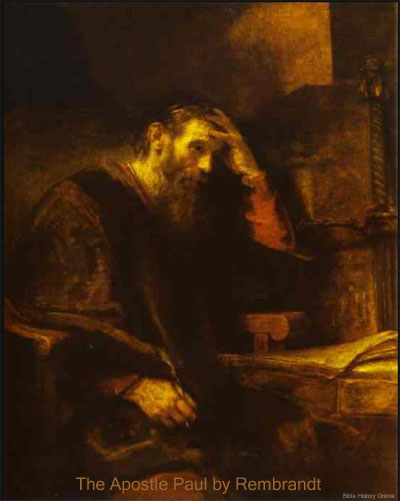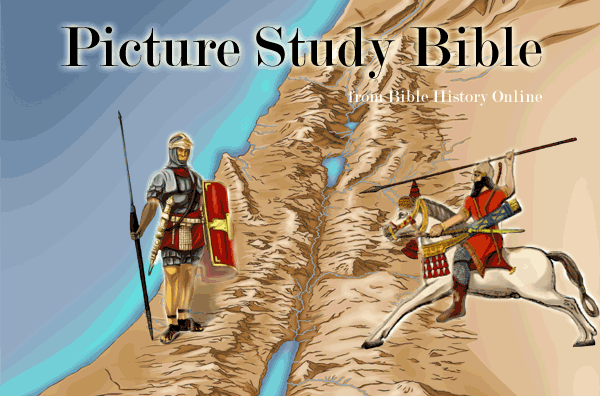Romans 5:14 Nevertheless death reigned from Adam to Moses, even over them that had not sinned after the similitude of Adam's transgression, who is the figure of him that was to come. - Free Bible Online
Romans 5:14 Nevertheless death reigned from Adam until Moses, even over those who had not sinned in the likeness of the offense of Adam, who is a type of Him who was to come.
14. Nevertheless death reigned from Adam to Moses, even over them that
had not sinned after the similitude of Adam's transgression--But who
are they?--a much contested question. Infants (say some), who being
guiltless of actual sin, may be said not to have sinned in the way
that Adam did [AUGUSTINE,
BEZA,
HODGE]. But why should infants be
specially connected with the period "from Adam to Moses," since they die
alike in every period? And if the apostle meant to express here the
death of infants, why has he done it so enigmatically? Besides, the
death of infants is comprehended in the universal mortality on account
of the first sin, so emphatically expressed in
Ro 5:12;
what need then to specify it here? and why, if not necessary, should we
presume it to be meant here, unless the language unmistakably point to
it--which it certainly does not? The meaning then must be, that "death
reigned from Adam to Moses, even over those that had not, like Adam,
transgressed against a positive commandment, threatening death to the
disobedient." (So most interpreters). In this case, the particle
"even," instead of specifying one particular class of those who lived
"from Adam to Moses" (as the other interpretation supposes), merely
explains what it was that made the case of those who died from Adam to
Moses worthy of special notice--namely, that "though unlike Adam and
all since Moses, those who lived between the two had no positive
threatening of death for transgression, nevertheless, death reigned
even over them."
who is the figure--or, "a type."
of him that was to come--Christ. "This clause is inserted on the first
mention of the name "Adam," the one man of whom he is speaking, to
recall the purpose for which he is treating of him, as
the figure of Christ"
[ALFORD]. The point of analogy intended here
is plainly the public character which both sustained, neither of
the two being regarded in the divine procedure towards men as mere
individual men, but both alike as representative men. (Some
take the proper supplement here to be "Him [that is] to come";
understanding the apostle to speak from his own time, and to refer to
Christ's second coming [FRITZSCHE,
DE
WETTE,
ALFORD]. But this is
unnatural, since the analogy of the second Adam to the first has been
in full development ever since "God exalted Him to be a Prince and a
Saviour," and it will only remain to be consummated at His second
coming. The simple meaning is, as nearly all interpreters agree, that
Adam is a type of Him who was to come after him in the same public
character, and so to be "the second Adam").
JFB.
Questions Related to this Verse
Where in Scripture is Adam a Type of Christ?Where In Scripture Does It Talk About The Depravity Of Man?
Where In Scripture Does It Talk About The Fall Of Man?
Where In Scripture Does It Talk About Justification?
Select a Chapter
-
Romans 1 |
Romans 2 |
Romans 3 |
Romans 4 |
Romans 5 |
Romans 6 |
Romans 7 |
Romans 8 |
Romans 9 |
Romans 10 |
Romans 11 |
Romans 12 |
Romans 13 |
Romans 14 |
Romans 15 |
Romans 16 |
Select a Book of the Bible
-
Genesis |
Exodus |
Leviticus |
Numbers |
Deuteronomy |
Joshua |
Judges |
Ruth |
1 Samuel |
2 Samuel |
1 Kings |
2 Kings |
1 Chronicles |
2 Chronicles |
Ezra |
Nehemiah |
Esther |
Job |
Psalms |
Proverbs |
Ecclesiastes |
Song of Solomon |
Isaiah |
Jeremiah |
Lamentations |
Ezekiel |
Daniel |
Hosea |
Joel |
Amos |
Obadiah |
Jonah |
Micah |
Nahum |
Habakkuk |
Zephaniah |
Haggai |
Zechariah |
Malachi |
Matthew |
Mark |
Luke |
John |
Acts |
Romans |
1 Corinthians |
2 Corinthians |
Galatians |
Ephesians |
Philippians |
Colossians |
1 Thessalonians |
2 Thessalonians |
1 Timothy |
2 Timothy |
Titus |
Philemon |
Hebrews |
James |
1 Peter |
2 Peter |
1 John |
2 John |
3 John |
Jude |
Revelation |
The Book of Romans
Romans 1:20 - For the invisible things of him from the creation of the world are clearly seen, being understood by the things that are made, [even] his eternal power and Godhead; so that they are without excuse:
Romans 8:28 - And we know that all things work together for good to them that love God, to them who are the called according to [his] purpose.
Romans in The New Testament - A Brief Overview

Painting of Paul the Apostle by Rembrandt - 1657
Introduction to The Epistle to the Romans
Brief Summary. Paul's message in his profound epistle to the Romans 1-8 is that a man is justified by faith in Christ and not by the works of the Law. Righteousness is by Christ alone, and when a man believes in Christ, he becomes dead to sin and the law and alive in Christ. The Holy Spirit sanctifies the believer and empowers him to live a holy life. A relationship with Christ brings adopted sonship and the assurance of salvation from sin. The question about the Jews and their fate is answered in Romans, they were chosen to possess the oracles of the Lord. Romans 9-11 reveals that the Jews failed to recognize Christ as the fulfillment of the Law and rejected their own Messiah. Therefore God rejected Israel, yet, this rejection is not total or final. Paul makes it abundantly clear that God will show mercy to those Jews who acknowledge Jesus as Lord. In Romans 12-16 Paul exhorts the Christians in Rome regarding the practical aspects of the new life in Christ.
Summary of The Book of Romans
Purpose. Paul was called by God to bring Christianity to the gentile world, and to establish churches for worship and ministry. Rome was the capital of the gentile world, and a church had developed there. Paul no doubt knew the strategic value of strengthening the body of believers by laying a strong doctrinal foundation. There is also indications that Paul had desired to preach the Gospel in Spain, and it would have been wise to create a solid base in Rome. Paul was continually challenged by the Jews regarding the Gospel of Christ and the Law of Moses. Paul obviously wanted to clear up any confusion by creating a strong doctrinal statement in his epistle. He addresses the same issues as in his other epistles, false doctrine, false teachers, and troublemakers who would stir up dissension in the church. In the epistle to the Romans Paul also introduces the deaconess Phoebe, he petitions the church at large to pray for the Roman brethren, and to greet the believers in Christ at the church in Rome.
Audience. The epistle begins with "to all God's beloved in Rome" and this would clearly indicate that Paul was addressing the Christian church in Rome. Throughout the book of Romans it is clear that in the church at Rome there were many Jews and gentiles.
Authorship. Paul the apostle is universally accepted as the author of the epistle to the Romans. Throughout the entire letter it is easy to see Paul's sincerity, his unique insights in the teachings about God, the Jews, Jesus and salvation to all mankind. Statements in the epistle indicate that Paul was going to Jerusalem with the collection for the poor which he had gathered (Romans 15:25-27).
Date. The epistle to the Romans appears to have been written near the end of Paul's third missionary journey, probably around 57 or 58 AD. One of the main reasons for this date is because 1 Corinthians and 2 Corinthians refer to this collection and this would indicate that Romans was written just after 1 and 2 Corinthians, toward the end of Paul's third missionary journey. Most scholars date the epistle near AD 58 and name Corinth as the city of its origin.
Outline of the Book of Romans
Doctrine and Theology - Chapters 1-8
God's Plan for Israel - Chapters 9-11
The New Life in Christ - Chapters 12-16

The Name Jesus In Ancient Hebrew Text
"Yeshua" in First Century Hebrew Text. This is how the name "Jesus"
would have been written in ancient Hebrew documents. The four letters or
consonants from right to left are Yod, Shin, Vav, Ayin (Y, SH, OO, A).
Jesus is the Greek name for the Hebrew name Joshua or Y'shua which means
"The LORD or Yahweh is Salvation".
Interesting Notes
- Some ancient manuscripts omit the word, "Rome," scholars generally agree that the epistle was addressed to the Christian church in Rome.
Romans Resources
Map of the Roman Empire (14 AD) - This map reveals the Roman Empire during the time shortly after the birth of Jesus, in 14 AD at the time of the death of Augustus. The order which prevailed in this extensive empire, the good military roads, and the use of Koine Greek as the general language of culture throughout the area were among the factors which multiplied the rapid spread of the Gospel of Jesus Christ. (Color Map)
Map of Paul's Third Missionary Journey (54 AD) - This map reveals the areas in Asia and Greece where Paul visited in his third missionary journey. On Paul's third missionary journey he returned to the cities he had first visited on his first missionary journey. During this time he decided to remain in Ephesus for about 3 years, and this city was the main focus of his activities and an important Christian community (Acts 19). (Color Map)
Map of Paul's Voyage to Rome (61 AD) - This map reveals the journey of the Apostle Paul to Rome in 61 AD. Paul had appealed to Caesar in Caesarea (Acts 24-25), his goal was to spread the Gospel of Jesus throughout the Roman Empire all the way to her great capital, Rome. He demanded that his case be heard by the Roman Emperor. According to the Book of Acts, after his shipwreck on the Island of Malta (Acts 28) he came to Italy and was put on house arrest for two years (Acts 28:30). (Color Map)
Map of the New Testament World - This map reveals the "Nations" within the ancient world during the first century A.D., the time of the New Testament. The map includes the areas of Israel, Asia, Greece, and Italy. (Color Map)
Map of New Testament Italy - This map reveals the cities
within Italy during the first century A.D., the time of the New
Testament. The map includes the principle cities of Italy like
Neapolis and Rome. Follow the path of the Apostle.
Bibliography Information
Free Bible Online Picture Study Bible, King James Version. New York: American Bible Society: www.free-bible.com, 1995-2013. Bible History Picture Study Bible. Apr 29, 2024.
- King James Bible Home
- Free Bible Home Page
- Bible Encyclopedia (ISBE)
- Online Bible (KJV)
- Naves Topical Bible
- Smith's Bible Dictionary
- Easton's Bible Dictionary
- Fausset's Bible Dictionary
- Matthew Henry Bible Commentary
- Hitchcock's Bible Dictionary
Read The Bible
- 1599 Geneva Bible (GNV)
- 21st Century King James Version (KJ21)
- American Standard Version (ASV)
- Amplified Bible (AMP)
- Amplified Bible, Classic Edition (AMPC)
- Authorized (King James) Version (AKJV)
- BRG Bible (BRG)
- Christian Standard Bible (CSB)
- Common English Bible (CEB)
- Complete Jewish Bible (CJB)
- Contemporary English Version (CEV)
- Darby Translation (DARBY)
- Disciples’ Literal New Testament (DLNT)
- Douay-Rheims 1899 American Edition (DRA)
- Easy-to-Read Version (ERV)
- English Standard Version (ESV)
- English Standard Version Anglicised (ESVUK)
- Evangelical Heritage Version (EHV)
- Expanded Bible (EXB)
- GOD’S WORD Translation (GW)
- Good News Translation (GNT)
- Holman Christian Standard Bible (HCSB)
- International Children’s Bible (ICB)
- International Standard Version (ISV)
- J.B. Phillips New Testament (PHILLIPS)
- Jubilee Bible 2000 (JUB)
- King James Version (KJV)
- Lexham English Bible (LEB)
- Living Bible (TLB)
- Modern English Version (MEV)
- Mounce Reverse Interlinear New Testament (MOUNCE)
- Names of God Bible (NOG)
- New American Bible (Revised Edition) (NABRE)
- New American Standard Bible (NASB)
- New American Standard Bible 1995 (NASB1995)
- New Catholic Bible (NCB)
- New Century Version (NCV)
- New English Translation (NET)
- New International Reader's Version (NIRV)
- New International Version - UK (NIVUK)
- New International Version (NIV)
- New King James Version (NKJV)
- New Life Version (NLV)
- New Living Translation (NLT)
- New Matthew Bible (NMB)
- New Revised Standard Version (NRSV)
- New Revised Standard Version Catholic Edition (NRSVCE)
- New Revised Standard Version, Anglicised (NRSVA)
- New Revised Standard Version, Anglicised Catholic Edition (NRSVACE)
- New Testament for Everyone (NTE)
- Orthodox Jewish Bible (OJB)
- Revised Geneva Translation (RGT)
- Revised Standard Version (RSV)
- Revised Standard Version Catholic Edition (RSVCE)
- The Message (MSG)
- The Voice (VOICE)
- Tree of Life Version (TLV)
- World English Bible (WEB)
- Worldwide English (New Testament) (WE)
- Wycliffe Bible (WYC)
- Young's Literal Translation (YLT)
Table of Contents
Main Menu
- Ancient Assyrian Social Structure
- Ancient Babylonia
- Ancient Canaan During the Time of Joshua
- Ancient History Timeline
- Ancient Oil Lamps
- Antonia Fortress
- Archaeology of Ancient Assyria
- Assyria and Bible Prophecy
- Augustus Caesar
- Background Bible Study
- Bible
- Biblical Geography
- Fallen Empires - Archaeological Discoveries and the Bible
- First Century Jerusalem
- Glossary of Latin Words
- Herod Agrippa I
- Herod Antipas
- Herod the Great
- Herod's Temple
- High Priest's in New Testament Times
- Jewish Literature in New Testament Times
- Library collection
- Map of David's Kingdom
- Map of the Divided Kingdom - Israel and Judah
- Map of the Ministry of Jesus
- Matthew Henry Bible Commentary
- Messianic Prophecy
- Nero Caesar Emperor
- Online Bible Maps
- Paul's First Missionary Journey
- Paul's Second Missionary Journey
- Paul's Third Missionary Journey
- Pontius Pilate
- Questions About the Ancient World
- Tabernacle of Ancient Israel
- Tax Collectors in New Testament Times
- The Babylonian Captivity
- The Black Obelisk of Shalmaneser
- The Books of the New Testament
- The Court of the Gentiles
- The Court of the Women in the Temple
- The Destruction of Israel
- The Fall of Judah with Map
- The History Of Rome
- The Incredible Bible
- The Jewish Calendar in Ancient Hebrew History
- The Life of Jesus in Chronological Order
- The Life of Jesus in Harmony
- The Names of God
- The New Testament
- The Old Testament
- The Passion of the Christ
- The Pharisees
- The Sacred Year of Israel in New Testament Times
- The Samaritans
- The Scribes
Ancient Questions
- How did the ancient Greeks and Romans practice medicine and treat illnesses?
- What were the major contributions of ancient Babylon to mathematics and astronomy?
- How did the ancient Persians create and administer their vast empire?
- What were the cultural and artistic achievements of ancient India, particularly during the Gupta Empire?
- How did ancient civilizations like the Incas and Aztecs build their remarkable cities and structures?
- What were the major trade routes and trading practices of the ancient world?
- What was the role of slavery in ancient societies like Rome and Greece?
- How did the ancient Mayans develop their sophisticated calendar system?
- What were the key events and significance of the Battle of Thermopylae in ancient Greece?
- What was life like for women in ancient Rome?
Bible Study Questions
- What does biblical archaeologist said about hieroglyphics?
- Where is the Negev where Abram went to in Genesis?
- What is the name of Ramallah in the Bible?
- How do we approach and study the historical and cultural context of biblical passages?
- What is the significance of the Psalms in personal and corporate worship?
- How do we discern and apply biblical principles to contemporary ethical issues?
- What is the biblical perspective on the nature of God's love and mercy?
- How do we interpret and understand apocalyptic literature in the Bible?
- What are the different covenants in the Bible and their significance?
- How do we grow in spiritual maturity and develop a deeper understanding of the Word?
About
Welcome to Free Bible: Unearthing the Past, Illuminating the Present! Step into a world where ancient history and biblical narratives intertwine, inviting you to explore the rich tapestry of human civilization.
Discover the captivating stories of forgotten empires, delve into the customs and cultures of our ancestors, and witness the remarkable findings unearthed by dedicated archaeologists.
Immerse yourself in a treasure trove of knowledge, where the past comes alive and illuminates our understanding of the present.
Join us on this extraordinary journey through time, where curiosity is rewarded and ancient mysteries await your exploration.
Recent posts
-

The Art of Custom Home Design: Unveiling Wellcore Corporation's Expertise
In the ever-evolving panorama of contemporary production, customization reigns ultimate as a testament to innovation and the preference for a without ... -

Birthstones: A Sparkling Symphony of History, Symbolism, and Self-Expression
Birthstones, the ones fascinating gems linked to our delivery month, boast a records as rich and multifaceted because the jewels themselves. Their tal... -

The use of medicinal mushrooms by different religions of the world.
The integration of medicinal mushrooms into various religious practices around the world is a fascinating testament to their revered status across cul... -

Explore a Collection of Religious SVGs
Religious SVGs are versatile design elements that can be used to create a variety of personalized and meaningful projects. Whether you're looking to e... -

Angel Numbers in the Bible: Unveiling Myths and Facts
In the vast tapestry of biblical narratives, angelic encounters and divine messages are woven into the fabric of spiritual revelation. Among the fasci...
